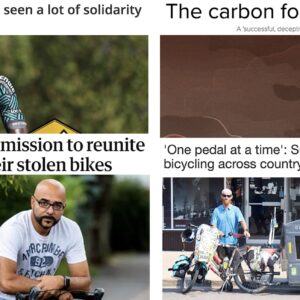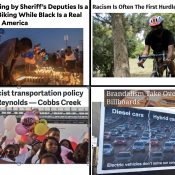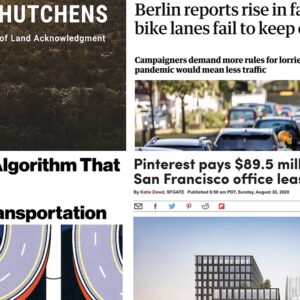Welcome to the week.
Below are the most noteworthy items we came across in the past seven days.
High on Oslo: The Norwegian city that has already proven they can reach “vision zero” is actively pursuing a zero-emission future.
Latest LeMonds: Famous bike racer Greg LeMond has raised eyebrows by re-launching his namesake brand with urban-oriented, carbon fiber e-bikes.
It’s just good politics: A national poll conducted by the League of American Bicyclists found the number of Americans who believe the federal government should invest more in safe cycling infrastructure has risen to 60%.
Death-free streets: Washington D.C. Council passed a set of measures aimed at reducing road deaths to zero by 2024 that includes infrastructure investments, increased enforcement of traffic laws via red light cameras, and many other provisions.
Swapfiets growing: We continue to watch Netherlands-based Swapfiets grow and expand their service that offers long-term rentals as an alternative to the more common short-term bike share system model.
Advertisement
Crisis exposure: Thanks to author and former Streetsblog writer Angie Schmitt’s new book Right of Way (Island Press, 2020), the national media is starting to pay a lot more attention to how the bulging size of new cars (and many other factors) have led to a “pedestrian safety crisis.”
EV dreams: “When you have a system in which structural failure is embedded, nothing short of structural change will significantly improve it,” says Guardian (UK) columnist George Monbiot about government promises to phase out internal combustion engines in favor of battery powered ones.
Newsom disagrees: The governor of California made national news by proclaiming he wants to rid the state of petrol-burning cars by 2035. For more context on the decision, read this quality Twitter thread by climate policy expert Dave Weiskopf.
‘Stand your ground’ law, but for cars: The horrifying trend of vehicular violence has made its way into legislation being proposed by the governor of Florida that would make it legal to run someone over with your car if you were “fleeing for safety from a mob”.
Year-long FAST: The recent spending bill passed by Congress included a re-authorization of the existing transportation bill called the FAST Act, which reformers bemoan as a giveaway to the highway industrial complex. Thankfully it will expire in just one year.
From plazas to promenade? Positive vibes are forming around making NW 13th in the Pearl District carfree thanks to inspiration from the on-street dining permit program from the City of Portland.
E-biking docs: British doctors and nurses are hopping on electric-assist bikes to zoom through traffic and make more home visits more quickly.
— Jonathan Maus: (503) 706-8804, @jonathan_maus on Twitter and jonathan@bikeportland.org
— Get our headlines delivered to your inbox.
— Support this independent community media outlet with a one-time contribution or monthly subscription.







Thanks for reading.
BikePortland has served this community with independent community journalism since 2005. We rely on subscriptions from readers like you to survive. Your financial support is vital in keeping this valuable resource alive and well.
Please subscribe today to strengthen and expand our work.
NHS doctors, finally a legitimate use for this!
1920 Headline: New York Plans to Ban Sales of New Oat-Fed Horses in 15 Years
Governor says it will help to reduce methane green house gas emissions and manure build up, expects regulators to develop a plan that would require horseless carriage makers to sell steadily more zero-emissions passenger vehicles in the state.
This sounds very much like you are apposed to banning the sales of combustion motor vehicles. If that is true, why is that your oppinion?
Bans on products 15 years into the future are impossible to enforce, since the ban can be undone by the next legislative or governor’s term, so this policy (and the related headline) are largely symbolic, a lot like “draining the swamp in Washington”. If it comes to pass, it will be through consumer choice rather than through regulation. But the actual reality will likely be something rather different and unexpected – it usually is.
Don’t get me wrong, I hate cars. I never learned to drive one, and at 52 now, I’m not likely to ever do so. But both the headline and the story behind it are rather silly and too easy to lampoon.
That’s a good way of putting it.
The automotive industry is very stodgy because cars are complicated products with complex supply chains. Were it not for massive scale of production, cars would only exist for the very rich. It takes the industry a while to turn the ship. A single entity announcing regulation like this means nothing, but California is jumping on the bandwagon already full of other very important markets. Their announcement in this context is both important and useful. Yes, sure, some ONE market may relax this a bit but ALL of them won’t.
The writing is on the wall for internal combustion. It may still be around in a couple decades as a novelty in a way that people still fly biplanes and drive steam cars but it’s pretty much done and not just thanks to regulation alone. There are very tangible performance and convenience reasons to own an EV.
I think it’ll take longer than a couple decades for internal combustion to be a mere novelty. Even in CA, if new ICE-car sales stop in 2035 it will take at least another decade for them to largely age out.
But I suspect, as DH suggests, that the industry and the market are going to drive things to where the ruling would be nearly redundant anyway. With Musk’s Battery Day announcements last week, it looks like we may have $25k economy EVs, as well as 10-minute recharging, by 2025, not 2035. (By the way, he promised 2023 … given his track record, it will probably take a couple years longer than promised, but will still happen). By 2035 even many of the niche uses where ICE make more sense will have been supplanted.
But the announcement, however irrelevant, sure prompted a lot of hand-wringing!
The corporate propagandists at the NYTs spun Newsom’s cynical PR piece as a ban on fossil fuel-burning cars but in Kalifornia gas-burning hybrid monster-SUVs are “zero emission vehicles”.
For example, the Mitsubishi Outlander has “zero emissions” when it burns through its 16 gallon gas tank at 25 mpg.
https://www.cnet.com/roadshow/reviews/2019-mitsubishi-outlander-phev-review/
Doesn’t look to me like CNet is either calling the Outlander PHEV a “zero emission vehicle,” nor are they particularly praising it.
As for the 2035 ban, I don’t read it to allow PHEVs like this. Only full-on BEVs will be allowed, as I understand it.
CNET has nothing to do with it. It’s the fracking state of California that classifies monstrous SUV hybrids as zero emission vehicles.
https://ww2.arb.ca.gov/our-work/programs/zero-emission-vehicle-program/about
Details on current ZEV classification here:
https://govt.westlaw.com/calregs/Document/I505CA51BB0AD454499B57FC8B03D7856?viewType=FullText&originationContext=documenttoc&transitionType=CategoryPageItem&contextData=(sc.Default)
“As for the 2035 ban, I don’t read it to allow PHEVs like this. ”
Sadly, this kind of hopium is the current state of climate activism in the USA.
My first suspicion was as you describe. California has a lot of wacky, unintuitive classifications of vehicles. However, ZEV is actually what it sounds like. The Mitsubishi you mentioned doesn’t qualify. From your own link (that I also found when reading the announcement), ZEVs are 2018 and newer…
The plug-in hybrid reference you alluded to on CARB’s web page is talking about emission-reducing technologies in general, not only ZEVs. There are a plethora of other classifications: transitional ZEV, PZEV, ULEV, etc. But this announcement is specifically ZEV. It could conceivably include non-battery technologies like hydrogen. It cannot include Priuses and similar partially-gasoline-powered options that are zero-emission only in one of multiple operating modes.
The page specifically described CARB’s “Zero-Emission Vehicle Program” which is codified by “1962.2. Zero-Emission Vehicle Standards”.
I linked to this above and it explicitly states that any vehicle with 10 miles or greater of all electric miles qualifies as a transitional ZEV under Ca Air Board regulations. Essentially every plug-in hybrid sold, including the Prius plug-in, qualifies as a ZEV under this law:
https://ww3.arb.ca.gov/msprog/onroad/cert/pcldtmdv/2020/toyota_pc_a0141038_1d8_s3-30_tz_phev.pdf
If Newsom had wanted to change the definition of ZEV to exclude transitional ZEVs he would have lobbied the legislature to pass a new law. However, he has not done this and specifically referenced current CARB regulations in his executive order.
TZEV != ZEV. The old regulations imposed a “ZEV credit percentage requirement” on manufacturers. The credit percentage requirement could be met in multiple ways, including with TZEVs or trading credits.
Text of the new executive order is here. Note that it uses “zero emissions vehicle” not TZEV nor credit percentage requirement. CARB is directed to develop (i.e. new, not existing) regulations to that end, which supports that this is a new and different requirement than the credit percentage requirement of yore. As you point out in your link, a Prius may be worth 0.88 ZEV in credit percentage requirement terms, but it is a TZEV, not ZEV. Per the executive order, Toyota can’t sell that Prius after 2035.
The regulations referred to in the order are the “1962.2. Zero-Emission Vehicle Standards” which specifically include T-ZEVs (for an indefinite period). This regulation was created by legislation that was codified into law (CA SB 498 — 2017). This is why he ended his order with a statement indicating that it complies with all existing laws.
The USA may be moving towards complete dissolution of the rule of law but Newsom does not yet have the right to void existing legislation by proclamation.
Fair point. The executive order is not an immediate change in law. It is at least a statement of aspiration, though, and the aspirations described are not possible if the existing 1962.2 is to be a limit. For one, the executive order concerns targets in 2035 and 2045, both well beyond anything described in 1962.2. (Well it does say “… and subsequent”.)
Can CARB, OBED, EC, PUC, etc. collectively use existing authorities to achieve more than what’s already in 1962.2? Probably. Can they reach a ZEV-only 2035 without legislative support? I don’t know, but they’re going to try, and maybe they will get legislative support. They can impose new requirements in addition to 1962.2; nobody needs to void any existing legislation.
To the impetus for my original reply: “If CA is successful” is an important qualifier, and there’s plenty of room to disagree on its likelihood. However, if CA is successful in carrying out this order, gas-burning hybrid monster-SUVs are not going to be flying off the shelves in 2036.
Here’s how I see it. Newsom’s order says to the executive branch, “We’re going that way. Start paddling together and there’s no excuse for misunderstanding the goal.” Whether Newsom and his deputies can make good on the vision will come down to messy details, but I don’t think it’s remotely fair to paint this as merely slapping a sticker over the check engine light and carrying on with business as usual.
It’s not even on life support. New auto sales are down about 20% compared to 2019. Used car sales are through the roof. The average car is 13 years old and speculation is that could increase to 14 or 15 years by the end of the year. The dealer we buy our used Subies from has never seen anything like this. He has added a couple of service techs to keep up with people spending money to repair their old car rather than replace it. Plug in electric sales are up and they now have 3.7% of the global market (as of July). Tesla sold over 200,000 units world wide. Of course in the same time frame over 1 million new trucks were sold in the U.S. even with sales down for the year. And when you think about ICE do not forget all the motorcycles, ATVs, UTVs, boats, RVs, Aircraft, power equipment and list goes on. I do believe that electric will eventually become the majority but I think it is a long way out.
People’s incomes have taken a hit this year, also.
Agreed. And we will likely have blown past our 1.5 C carbon budget by the time this happens.
2 C is the new 1.5 C.
I work in heavy duty trucking and we build our roadmaps for new technologies based on regulations and EOs like these. It takes forever to come up with new powertrains, if they said they wanted to do it next year it wouldn’t be possible.
I see the logic to this, however, this is not a brand new discussion. To suggest that the trucking industry is caught off guard by the need to engineer new drive trains is something between whimsical and wildly frustrating. This argument makes the trucking industry appear to be resistant to change.
And the trucking industry will have plenty of time. The 2035 ban applies to automobiles and light trucks only, not to medium and heavy duty trucks … or trains burning diesel, or planes burning kerosene, or ships burning bunker fuel.
… or the trucking industry might not have that much time, if they want to stay competitive. Tesla is taking orders for their Semi, with deliveries planned in 2021. Maybe the “trucking industry” can’t do it next year, but Tesla just might.
Um… This is *California* making this regulation. It’s not exactly a swing state subject to large political shifts, If I were in the auto industry, I would be assuming the ban will in fact go into effect in 2035. And, it’s not like California is a bleeding-edge global leader here, The UK is saying 2030, for example.
And, as someone pointed out below, regulation has in fact caused large technological change in the auto & trucking industries in the past (e,g, catalytic converters, fuel economy).
Overall, since the technology is already extant and well known, and the populace understands all too well (due to recent fires and heatwaves) the reason for the policy, it seems extraordinarily unlikely to me that a future governor or legislature would reverse the policy.
This “regulation” is nothing more than a governor’s unenforceable and misleading proclamation (it does not even ban petrol-burning cars). There also seems to be little interest in this kind of legislation from California Democrats as evidenced by the failure of a much weaker bill.
California, like Portland, has a long history of making fantastical climate proclamations that it has absolutely no intention of meeting.
https://www.technologyreview.com/2019/11/01/102477/california-is-on-track-to-miss-its-climate-targets-by-a-century/
“ Following the order, the California Air Resources Board will develop regulations to mandate that 100 percent of in-state sales of new passenger cars and trucks are zero-emission by 2035”
https://www.gov.ca.gov/2020/09/23/governor-newsom-announces-california-will-phase-out-gasoline-powered-cars-drastically-reduce-demand-for-fossil-fuel-in-californias-fight-against-climate-change/
This seems to me like the kind of thing California will actually do. Reduce consumerism or build lots of dense housing? No. Mandate technological change which will only address a portion of the carbon problem? Yeah, that’s on brand.
Gas-guzzling SUVs are far more “on brand” in California and Oregon. I very much doubt that either state will make any meaninful progress on transportation emissions in the next decade.
https://www.sacbee.com/news/politics-government/capitol-alert/article235758522.html
I fully expect Californians and Oregonians to buy electricity-guzzling SUVs and pickup trucks in the years to come.
Year-long FAST: The article as usual blames the Senate Republicans, but barely notes that the vast majority of House Democrats also voted to continue FAST for another year, that they didn’t even try to put their INVEST act up for a House vote. Aside from a few die-hards on both the right and left, there isn’t much ideologically that separates most Democratic and Republican lawmakers, they are both are both Christian Democrats (excuse my German) at heart, both in favor of the status quo, both wanting to get re-elected at pretty much any cost, including selling their souls to the biggest PAC.
Anything to do with Americans’ transportation habits instantly turns any US politician into a terrified, cowering infant–so what’s new?
“The Norwegian city … is actively pursuing a zero-emission future.”
A “zero-emission” future funded by fossil fuel production.
https://www.dw.com/en/norways-climate-hypocrisy-clean-at-home-dirty-in-the-arctic/a-40121909
Point taken.
Wish I lived in a country that had foresight to dedicate even a percentage of fossil fuel profits to future sustainability.
Happy to see momentum for capturing NW 13th Avenue for foot powered humans! But I’d really like to see action from the City to convert the full block at E. Burnside/Sandy/12th-13th to a plaza, square, or whatever. Its now surrounded by brand new, dense (by Portland standards) housing that cries out for public space.
Really glad to see Greg LeMond getting back into the bike biz. He called Lance on his PED BS long before anyone else had the guts to, and got shredded for his efforts. Hope he’s successful!
Uh, Lance was doing what everyone was doing in the peloton. He was better at it than many, but was hung due to being a dick. Apparently Greg can’t climb anymore. That’s just sad. If it has a motor it’s simply not a bicycle. Better avoid trails on mopeds. Mountain bikers don’t approve. Road 44 and all of the trails in Bend do not allow mopeds. Oh, those groups do ALL OF THE TRAIL MAINTENANCE.
bi•cy•cle bī′sĭk″əl, -sĭ-kəl, -sī″kəl
n.
A vehicle consisting of a light frame mounted on two wire-spoked wheels one behind the other and having a seat, handlebars for steering, brakes, and two pedals or a small motor by which it is driven.
Unfortunately, your perception is outdated.
We can all find definitions that fit our needs.
Merriam-Webster: a vehicle with two wheels tandem, handlebars for steering, a saddle seat, and pedals by which it is propelled.
Guess what, you didn’t debunk me. An e-bike has a motor, as well as pedals for propulsion. By your definition, an e-bike is a bicycle.
So is a horse with a bicycle hanging on it.
No, because the horse is porting the bicycle. The pedals of the bicycle being ported would not propel the horse when turned. Whereas, e-bikes are propelled by the pedals when they are turned.
Don’t be daft David.
Good semantic point! – I often get motors and engines confused. But ebikes can be used without the pedals be used, too.
Since you brought up the subject of your confusion, you do seem confused by a plethora of simple details.
I almost just ignored this. But in the interests of maintaining decorum, what purpose does a comment like this serve? I read it as basically a gratuitous insult. That doesn’t further the discussion, the community, or any desirable attribute of the comments section that I can see.
To be honest, the snide quip I was replying to was on par.
It’s an object lesson in, “don’t bring your own character into the argument”. Once you do, it becomes a topic of conversation.
Frankly, I’ve been lampooned enough over a very simple fact. Now, I get to lampoon back. 😉
I don’t see you criticizing anyone else for their stupid remarks.
Good to see Greg LeMond return to his passion for bikes. There’s certainly a lot of room left for more e-bike offerings but I think the real nexus of carbon fiber and motor assist is in MTB’s. I haven’t hit any serious trails this year because 2020 madness but I expect to see more of these out there soon.
Anyone have any personal trail “data” to share?
I know that because of the pandemic, trail usage has gone way up on the 44 miles of city parks off-road trails in Greensboro NC, as are local bike sales, including and especially for off-road ebikes. I’ve heard similar stories up and down the East Coast.
“urban-oriented, carbon fiber e-bikes”
Maybe someone can explain this to me. I feel like “urban” means: smash it around, bang it up against bike racks, etc. Why would someone want a carbon fiber e-bike for “urban” use?
It’s a $4,800 fashion-conscious light-weight upright lifestyle bike for the Portland slacker in all of us, to spin down the bike boulevard to get a cappuccino at Starbucks, which we’ll naturally lock with a matching Ottolock of course, because it looks cool, and it makes us look, well, like, you know…
“I feel like “urban” means: smash it around, bang it up against bike racks, etc. Why would someone want a carbon fiber e-bike for “urban” use?”
It’s funny because Greg was making a similar point when he rolled out the LeMonde Washoe, a steel bike.
Just because carbon has been used to make the lightest possible racing frames that crumple when subjected to anything but forces expected of a bicycle doesn’t mean that this has to be the way going forward. For one, frames can be made “solid” which would greatly increase their durability.
But the other point you make is harder to solve. How do you lock up a $5K bicycle? I think e-bikes are going to have to address this before they gain wide acceptance for urban use. In the meantime, there’s always Biketown.
Maybe use that technology (rejected in the gun industry) by which the bike bricks itself if you don’t have the right chip in your cheek? And no doubt proprietary parts that don’t yield to the usual three allen keys.
All my bikes are steel. I’ve been waiting for the carnage from failed carbon fiber forks but it keeps not happening. Maybe the flexible design and ridiculous strength of the material has surpassed its possible deficiencies?
It would be just all right with me if my beloved 70 pound cargo bike suddenly started weighing about 15 kilos…
As someone who used to have a multi-thousand-dollar e-cargobike (note: you can get a good e-bike for way less than $5000, especially now) – you buy multiple hundred-dollar, very heavy locks. I had a 6-pound u-lock and a giant, 15?-pound chain lock. An e-bike makes transporting them easy. No big deal.
Having to carry around multiple pounds of locks probably does cut into the urban carbon fiber sales pitch, though. (Though is that really all that different from what one has to carry around for a garden variety bike?)
I believe the Washington DC link is incorrectly pointing to the Oslo article?
NHS doctors, pssht.
If it was good enough for the midwives, it’s always been good enough for the doctors.
Gavin Newsom just *might* be an even worse governor than Kate Brown. Instead of worrying about 2035, how about he worry about the homeless disaster unfolding right now in his state of dreams that everyone is fleeing from?
There are too many people on the planet. That’s Newsom’s fault?
That’s not because of “too many people on the planet”.
Just don’t ask him about his “final solution”.
Jonathon, the second link in the “Crisis exposure” blurb routes to the site of the “High on Oslo” link.
Thanks for catching that Steve! Here’s the correct link to that USA Today story about the “pedestrian safety crisis” – https://www.usatoday.com/story/money/cars/2020/09/17/pedestrian-safety-crisis-right-of-way-book-angie-schmitt/5807237002/
Allow me to note that I recognize this as pedantic, but shame on that journalist for describing the wheels as blue when it is obviously the tires that are blue.
Another reason to transform NW 13th: it was “constructed or reconstructed” since the Pedestrian and Bicycle Bill became Oregon law 49 years ago. That law requires ped and bike facilities on all streets in Oregon when they are constructed or reconstructed. Other streets in NW Portland that violate the law include the Hoyt Yards development area around the west end of the Broadway Bridge, and NW 23rd Ave south of Lovejoy. North of Lovejoy is slated for reconstruction soon, with no plans for a compliant bike facility.